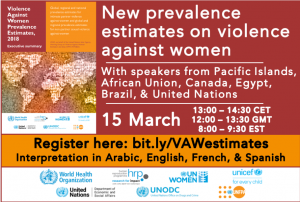Further information below for the panel event on WHO’s recently launched violence against women estimates. This event will take place on Monday 15 March from 13:00-14:30 CET, 14:- 12 – 1.30 CMT and 8:00-9:00 EST .
The key findings of the Report will be presented and a panel of data producers and users (policy makers) from countries will share their expertise and insights on the importance of strengthening country capacity to produce, collect, report and use prevalence/survey (and other) data on violence against women.
They will also briefly introduce the interactive data visualization platform which will make the WHO global database on the prevalence of violence against women publicly accessible.
Background The World Health Organization, on behalf of the Violence Against Women Inter-Agency Group on Estimation and Data (VAW-IAGED), will be presenting a new report, Violence against women prevalence estimates, 2018.
The report presents global, regional, and national prevalence estimates of physical and/or sexual intimate partner violence against women, as well as global and regional estimates of non-partner sexual violence against women. These are the first estimates on violence against women within the United Nations Sustainable Development Goals (SDGs) period. The analysis uses evidence from all eligible national and sub-national prevalence studies conducted between 2000 and 2018 gathered through a comprehensive systematic review of publicly available prevalence data, data repositories and additional data provided by countries’ national statistics offices. The estimates include data for 158 countries.
These new estimates reiterate that violence against women remains a public health problem and human rights violation of pandemic proportions that preceded the COVID-19 pandemic and will continue long after it. It is putting the health and well-being of women and their children at risk, all over the world, with substantial social and economic costs to individuals, families and countries. It is critical that governments invest in evidence-based sustainable and long-term measures to prevent violence against women. The prevalence estimates provide a way to track progress of governments over the long term in preventing and ultimately ending violence against women.
Objectives – To explain and disseminate the estimates on violence against women – To foster a dialogue between users and producers of violence against women data on how it can be most useful to countries – To highlight the importance and need for strengthening country capacity to produce, collect, report and use prevalence/survey data on violence against women – To introduce the violence against women data visualization platform
The registration details are on the flyer below:



